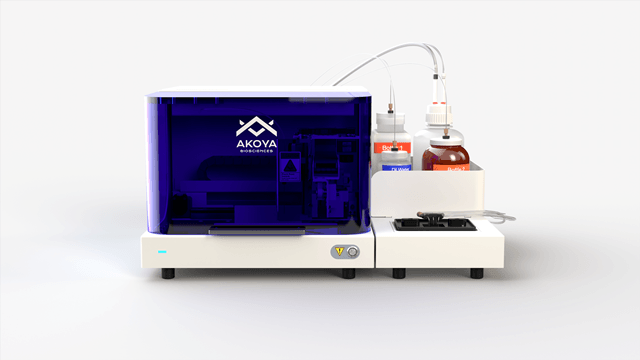
These include the CODEX System, an ultra-high multiplexing platform for tissue analysis and biomarker discovery, and Phenoptics 2.0, the company’s next-generation biomarker multiplexing platform. The new platforms provide scientists with a comprehensive end-to-end solution for multiplexed immunofluorescence from discovery through clinical and translational research.
The proprietary CODEX System, developed in the lab of Dr. Garry Nolan at Stanford University and exclusively licensed to Akoya, includes a fluidics-based instrument, reagents, and a software analysis suite. It offers a cost-effective means to transform customers’ existing fluorescence microscopes into ultra-high-parameter tissue imaging systems.
Users can simultaneously analyze more than 40 protein markers for spatially resolved tissue characterization with single-cell resolution, even in challenging samples such as highly auto-fluorescent FFPE and fresh frozen samples. The system offers the flexibility to design custom panels using a combination of Akoya-validated, ready-to-use antibodies and customers’ antibodies of interest.
Upon receiving the first commercial CODEX system, Dr. Nolan commented: “The commercial launch of CODEX is a proud milestone for my lab and an exciting opportunity for biomedical sciences. The ability to simultaneously and economically analyze dozens or more protein markers on intact tissues will fundamentally change our understanding of cellular interactions and disease biology.”
Akoya has also launched Phenoptics 2.0, the company’s first full product release following its acquisition of the Phenoptics business unit from PerkinElmer, Inc. (see press release). Phenoptics 2.0 is powered by the latest advancements to the Vectra Polaris™ imaging system, Opal™ detection reagents, and inForm® analysis software.
With this release, the company is introducing its proprietary MOTiF™ technology, which acquires multispectral images on whole-slide tissue sections of up to seven colors simultaneously, and 20 times faster than previously possible. The ability to process up to 30 whole-slide images per day makes this platform ideal for translational and clinical research studies. In addition to MOTiF, Phenoptics 2.0 enables multispectral analysis of up to nine colors in regions of interest for deeper interrogation of tissue samples.
Bernard Fox, PhD, at the Robert W. Franz Cancer Research Center, Earle A. Chiles Research Institute, Providence Cancer Center was one of the first researchers to apply the MOTiF technology to his studies. “With the advancement of so many new therapeutic options, it’s imperative that we address the critical need for identifying the right biomarkers to improve treatment outcomes for cancer patients,” he said. “The addition of MOTiF technology to Phenoptics now provides us the right platform that can help generate large-scale clinical trial data for the validation of new biomarkers. Our experience with the implementation of this technology makes me optimistic that we will soon have a solution to better stratify patients for clinical trials and ultimately provide tailored therapy that will result in improved patient outcomes.”
“Akoya is excited to bring unprecedented power, scale, and automation to histology through the power of multiplex immunofluorescence,” said Brian McKelligon, Chief Executive Officer of Akoya.
“The commercial availability of CODEX is a major achievement for Akoya and the release of Phenoptics 2.0 underscores the successful and rapid integration of the Phenoptics division from PerkinElmer into Akoya. We are proud to establish our market leadership in high-parameter tissue analysis with these transformative tools and to catalyze scientists’ ability to identify predictive biomarkers.”
The company is hosting a webinar on Tuesday, April 30th to provide an overview of both the Phenoptics and CODEX technologies. To register for the event, visit the registration page: Akoya Webinar Series: Defining the Future of Biomarker Analysis: From Discovery to High Throughput Studies.
Akoya will also be featuring its complete solution at the upcoming American Association for Cancer Research annual meeting in Atlanta from March 31-April 3, including multiple poster presentations and a workshop.
Source: Company Press Release






